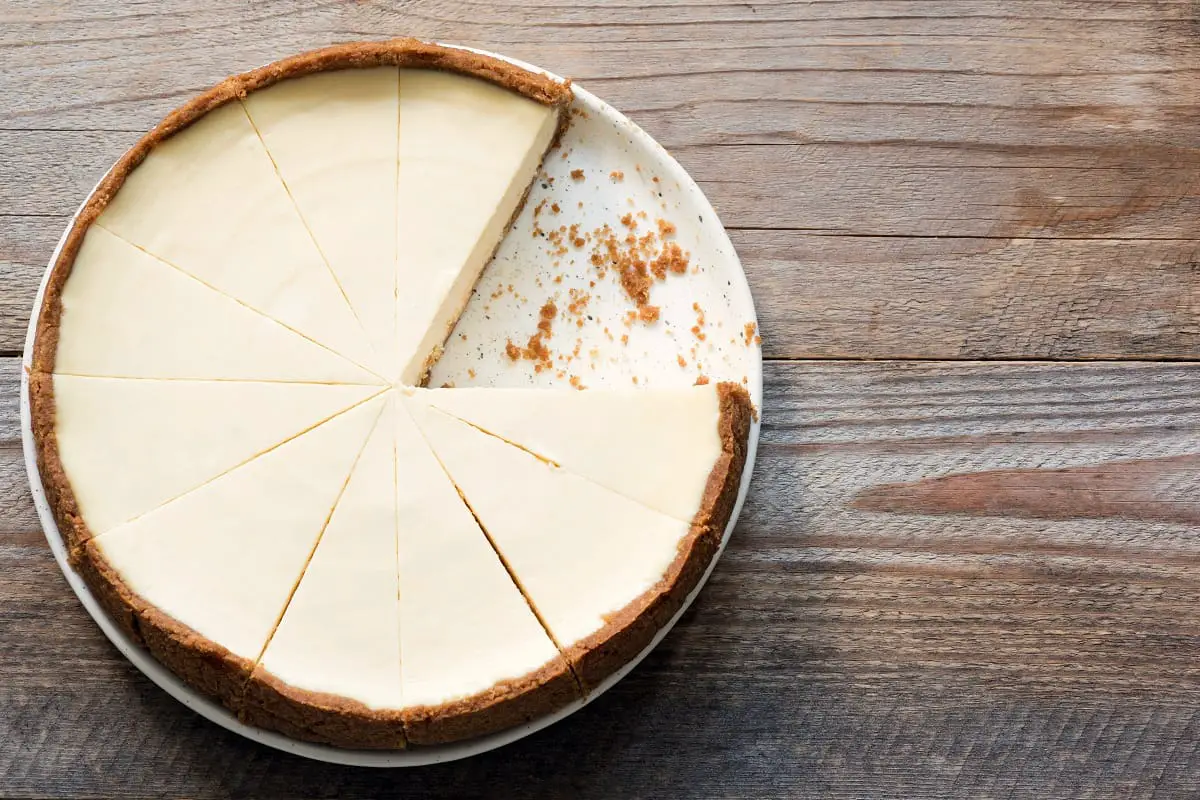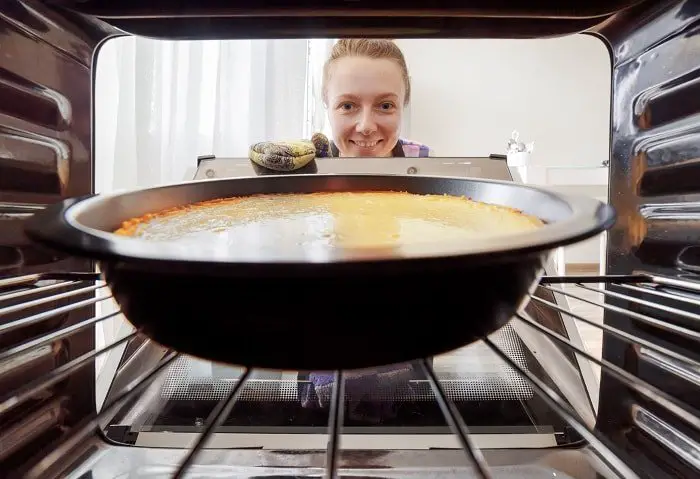Last Updated on December 29, 2022
It is tricky to know when to take the cheesecake out of the oven, so today we will discuss how to tell if the cheesecake is done. Baked cheesecake is definitely one of my absolute favorite treats but it can be easy to either under or overcook it -and burn it!
Help! How to Tell if Cheesecake is Done?
Jiggle it!
The most common mistake is to bake cheesecake as you would any other cake. The techniques you know for not taking an underbaked sponge out of the oven do not apply. Stabbing a cheesecake in the middle with a skewer or a knife is not a great indicator. This is because it will always come out wet! That is unless it is already overbaked.
If you have tried an overbaked cheesecake you know just how much of a disappointment that can be… All its creaminess is gone! Such a waste!
To actually tell if a cheesecake is perfectly baked, we need to shake it. Yes, you read that right. Shake it in the pan to see how much jiggle it has. You are looking for a small jiggle in its center. It needs to look nearly set, except for a small circle in the middle that still moves around a bit. Maybe you think that this jiggle means it is underbaked but I will let you in on a secret. Even when you take things out of the oven, they continue to cook until all of the preparation cools down.
This means that after taking it out of the oven, the cheesecake will continue to cook in its center for a while. Pulling it out when it still displays a slight jiggle will be perfect once it is completely cooled.
Of course, different types of cheesecakes differ, not only regarding the finished product but also in their in-oven jiggle. Specifically, sour cream cheesecakes will jiggle a little more. This is because we are looking for a slightly gooier center once cooled.
Touch it!
It may seem counter-intuitive to touch something that has been in the oven for some time. It is, though, a great way of knowing if your cheesecake is done!
With clean hands, lightly press the center of the cake’s surface. You want to feel that it is firm but still has to give. Of course, if your fingers sink into it with little resistance or come out with batter on them, it needs more time. Be patient!
Check the Center Temperature
This is the most accurate method of knowing if cheesecake -and, actually, anything you cook in the oven- is done, but also the most specific. Once the center reaches the correct temperature, then it’s time to take it out!
The only way of doing this is with the aid of an instant-read cooking thermometer. It needs to be “instant” because a few minutes could be the difference between correctly cooking and burning something. For cheesecakes, the temperature you are aiming to achieve in its center is 150ºF or 66ºC.
What to Do After Cheesecake is Done Baking?
When a cheesecake is finished baking, the most important thing to do is allow it to cool down and set. I’ve found that sudden jumps in temperature can affect the appearance of the cheesecake, so once it’s baked, turn your oven off and open the door. However, leave the cheesecake in there for around an hour to get used to the temperature. If you’d prefer, you can place your cheesecake on a wire rack and leave it for a few hours to cool at room temperature. Once at room temperature, you can then wrap it in plastic wrap and place it in the refrigerator. You should leave it for at least 4 hours, but overnight is ideal.
Before you place it in the fridge, you may want to add some toppings to your cheesecake. Some of my favorite cheesecake toppings include:
- fruit slices
- fruit compotes (such as strawberry or raspberry)
- chocolate shavings
- melted chocolate
- flavored syrup
- caramel sauce
- candy or cookies (Oreos or Reece’s work well)
- smooth peanut butter
How Long to Bake a 10 Inch Cheesecake at 350?
10 inches is the average size for a cheesecake so most recipes will use the right amount of ingredients and baking time for this sized cheesecake. I’ve found that baking at 350F for around 55-70 minutes is ideal. You should start to keep a watchful eye on it from around 55 minutes so that it doesn’t overbake or burn. The cheesecake should just be set on the outside, but jiggly in the middle if you gently shake it.
How Long to Bake Oreo Cheesecake?
Oreo cheesecake can be baked in one of two ways. Before you begin you should wrap the bottom of the pan with foil or place a silicone pan wrap inside. For the first method, preheat your oven to 325F and bake in the center of your oven for around 70-80 minutes.
If you notice the top of the cheesecake browning, just place a piece of foil over the top. Another method is reducing the temperature to 300F and baking for around an hour. Remember, the edges should be just set, but the center should be jiggly when gently shaken. After this time, turn the oven off, but leave it in the oven with the door closed for an additional hour.
How Long is Cheesecake Good After Baking?
Once a cheesecake has been baked, it all depends on how and where it’s stored and to how long it remains fresh and edible. If kept in the pantry at room temperature, it should not be left out for more than two hours. After this point, it will no longer be safe to consume. If stored in the fridge in an airtight container, your cheesecake will last anywhere from 3-5 days. And finally, if kept in an airtight container in the freezer, your cheesecake will last between 1-2 months.
How Many Degrees to Bake Cheesecake?
The best temperature to bake cheesecake is anywhere between 300-350F. The lower the temperature, the longer the cheesecake should be baked. My preferred temperature for baking cheesecake is 325F and baking in the center of a preheated oven for around 70-80 minutes.
How Do You Bake Multiple Cheesecakes?
To bake multiple cheesecakes at the same time will all depend on how big your oven is. However many you’re baking at once, it’s important to ensure they’re on different racks and also not directly below or above one another. Off-center is the best place for the cheesecakes, on different racks. This helps to even out the heat distribution. It’s also important that at the halfway point you switch the cheesecakes around. For example, change the bottom cakes to the middle rack and the middle cakes to the bottom rack.
Does Cream Cheese Curdle When Cooked?
There are a few reasons why your cream cheese may curdle when cooked. Let’s take a look at some of the main reasons for this problem.
- the temperature of ingredients. All ingredients should be at room temperature when making your cheesecake. If not, this may cause the cream cheese to curdle.
- overmixing. If you mix your cheesecake batter too much, it will likely split and then the cream cheese is more susceptible to curdling.
- baking method. If the oven temperature is too hot, or the cheesecake is overbaked, these can contribute to cream cheese curdling.
- using acidic ingredients. Ingredients like lemon in a cheesecake can cause cream cheese to react and curdle much more quicker. If you’re using ingredients that contain acid, be quick to prepare your batter and place it in the oven to avoid curdling.

Karen is a passionate pastry chef who loves to create delicious baked goods. She has been in the culinary arts for over 10 years, honing her skills and perfecting her craft. Karen is known for her creativity and attention to detail, creating unique desserts that bring a smile to everyone’s face. She is always looking for ways to challenge herself and come up with new recipes that are both tasty and visually appealing. Karen loves to experiment with different flavors and textures, and she is committed to providing the highest quality of products to her customers.


